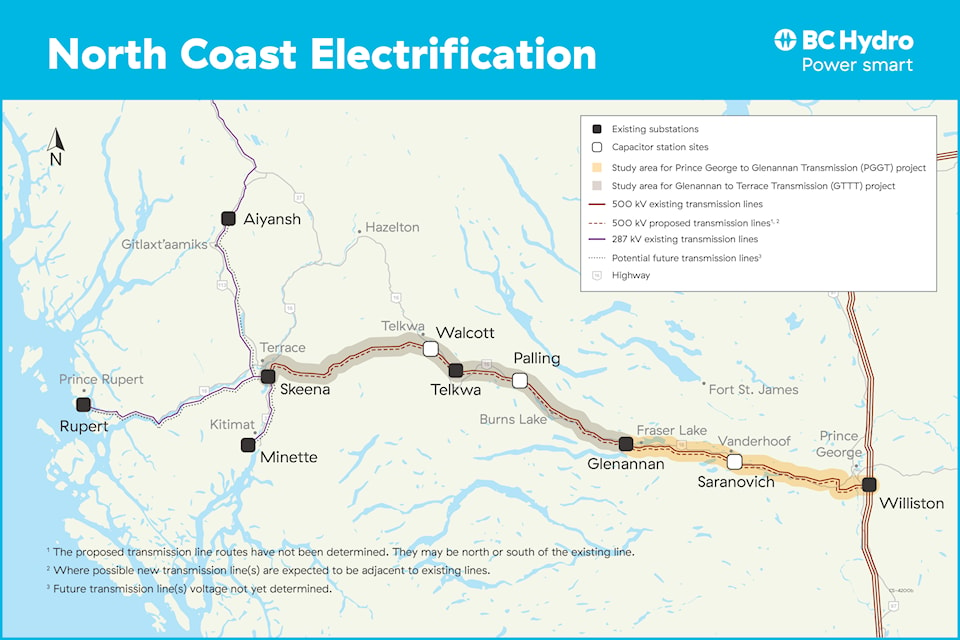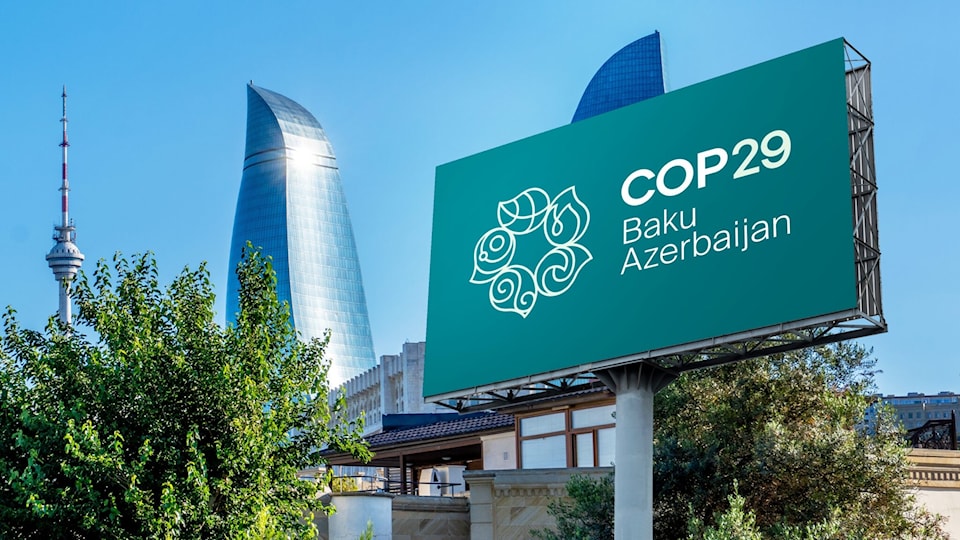The First Nations Climate Initiative (FNCI) is going to its third straight United Nations climate conference (COP29) with the Canadian delegation.
At the conference in Baku, Azerbaijan, a country off the coast of the Caspian Sea, FNCI plans to call on the B.C. and federal governments to make policy and regulatory changes that enable large net-zero infrastructure projects, boost economic development for B.C and Canada through partnerships, and further reconciliation with First Nations. They have several detailed goals for the global summit taking place between Monday, Nov. 11 to Friday, Nov. 22.
"Everybody knows that Canada's greenhouse gas emissions footprint isn't that significant in a global context. But our resources, if they're produced and managed in the right way, they can have a big impact. We can help others decarbonize, as well as decarbonize ourselves," said Alex Grzybowski, FNCI facilitator and CEO of K91ÂãÁÄÊÓƵ™uul Power+, who is a part of the delegation.
Decarbonization refers to shifting away from fossil fuels to renewable energy sources as quickly as possible.
"That's what it's all about acting globally and benefiting locally, transforming our economy while we participate in global trade that is oriented towards decarbonization," Grzybowski continued.
FNCI was established in 2019 and is led by the Haisla, Metlakatla, Nisga'a and Halfway River First Nations.
Canada-Asia Decarbonization Opportunities project
In 2023, Robert Johnston independent research advisor to FNCI and research director of the Center on Global Energy Policy, that identified ways in which Canadian resources could contribute to decarbonization in Asia. Johnston is also part of the delegation travelling to Baku.
"In particular, we'd like to work with countries that have a lot of affinity with Canada, like Korea and Japan," said Grzybowski. "We get along really well, we have very similar policy orientations with respect to climate change and they need our help or our resources to decarbonize their economies.
In addition to presenting at the Canada Pavilion, FNCI is hosting an event at COP29 titled "Decarbonization in Asia: Contributions from Canadian Indigenous Communities & Their Partners, 'Lessons from the Grease Trail'." They hope to further their economic and environmental collaboration with Asian countries through this event.
Grzybowski shared an example of decarbonization that Japan is undertaking.
"Last year, Japan of tens of billions of dollars in subsidies to purchase ammonia so that they reduce the GHG footprint of their coal-fired plants," he said. "What that means is they mix the ammonia with the coal and when they burn the mix, the carbon footprint of the process goes down because ammonia doesn't produce GHG."
"Where are they going to get the ammonia from?" he asked. "Canada."
"If we were to use methane pyrolysis, the methane molecule is broken down into solid carbon and hydrogen by heating it. We could use the solid carbon for other purposes, like graphite for batteries, asphalt for roads and more. You can manufacture ammonia by combining hydrogen with nitrogen, which is the most common gas in the atmosphere. You get ammonia and it's GHG free."
There are four methane pyrolysis pilot projects in B.C., two of which are working with FNCI Nations 91ÂãÁÄÊÓƵ” Innova Cleantech in Prince Rupert and New Wave Hydrogen in Burns Lake. There will be more details released regarding these projects following COP29, but FNCI is calling for Asian and Canadian private and public sector organizations to partner with them on these projects.
FortisBC is working with Australian tech company Hazer to set up a production facility. They received $8 million in provincial funding in 2022. They originally planned to build it at Suncor's Burrard terminal in Port Moody, but they withdrew in 2023 "as a result of a corporate portfolio review." FortisBC and Hazer are still searching for an alternative site in B.C.
Vancouver-based company Ekona Power is developing a methane pyrolysis reactor at its test facility in Burnaby. Operational testing is set for 2025 and it is expected to be commercially ready by 2026. One of Ekona's investors is Mitsui & Co., a Japanese global investment and trading company.
Grzybowski shared this process can be useful in other ways in Japan and Korea. These two countries are home to some of the biggest steel manufacturers in the world 91ÂãÁÄÊÓƵ” Nippon Steel in Japan and POSCO in Korea.
"They're trying to make green steel, which the world needs. It's very difficult to decarbonize steel production. They're looking at ways to do it and we're looking at how we can partner with them," he said.
FNCI is calling for the B.C., Alberta and federal governments "to adopt policies and enter international partnerships that ensure that Canadian low-carbon resources and emerging decarbonized fuels contribute directly to GHG reductions and decarbonization in the countries that are our trading partners."
First Nations collaboration
One FCNI's goals is to show the benefits of working with First Nations on zero-emission and low-carbon energy and resource projects. First Nations across Canada are currently developing and partnering in major projects that will add billions of dollars to provincial coffers.
In May of this year, 35 First Nations throughout B.C. received 9.8 million dollars through the British Columbia Indigenous Clean Energy Initiative, or BCICEI, for alternative energy projects. These projects include small- and large-scale solar arrays, home energy efficiency retrofits, a 40-megawatt wind project and more. Since 2016, the BCICEI has supported 174 First Nations projects.
The initiative is a clean-energy funding partnership between the federal government, B.C. government and the New Relationship Trust.
Nature-based solutions
Another goal is to demonstrate how nature-based solutions such as restoring ecosystems act as carbon sinks with the newly designed , or B.C. OBPS, that FNCI has been advocating for. It is replacing the that will be phased out by the end of 2024.
The new performance-based system ensures there are incentives for industrial emitters to reduce greenhouse gas emissions while also promoting innovation and competitiveness. Instead of paying the carbon tax on fuels and combustibles they use or burn, they will face a separate carbon price on the portion of their emissions that are above the product-specific emissions limit.
Companies are obligated to emit less than their annual emission limit, which is determined by the capacity of their operation. For example, if a company emits over the limit of 10,000 tonnes of carbon dioxide equivalent 91ÂãÁÄÊÓƵ” all greenhouse gasses emitted, not just carbon emissions 91ÂãÁÄÊÓƵ” they must pay for each tonne above the limit.
Companies have the option of paying a monetary amount or through compliance mechanisms. If monetary, the charge is 80 dollars per tonne of carbon dioxide equivalent, and that price will rise 15 dollars each year. Compliance mechanisms include purchasing B.C. offset units, which could include investing in an approved project on the B.C. Carbon Registry, such as a First Nations ecosystem restoration project.
Purchasing an offset unit is cheaper than paying the carbon tax and more effective, said Grzybowski.
"If companies pay the industrial carbon tax, how much of it actually goes into mitigating climate change? It's a very difficult question to answer," he said. Instead, "when they purchase a credit or offset from First Nations, their money goes into restoring those ecosystems so they can suck carbon dioxide out of the atmosphere. That's a really significant difference."
"Which would you rather do? It's kind of a no-brainer," he continued.
If companies emit under their annual emissions limit, they will also earn credits in the form B.C. OBPS earned credits. These credits can be traded to companies who were over the limit or saved up to meet a future compliance obligation.
Either way, projects in the B.C. Carbon Registry get investment and carbon is potentially removed from the atmosphere.
According to a press release, "FNCI has buyers ready to purchase millions of tonnes of high-quality offsets91ÂãÁÄÊÓƵ”those that are verified, additional and credible91ÂãÁÄÊÓƵ”from these and other Indigenous NBS (Nature Based Solutions) projects in B.C."
However, the use of these units is limited. In 2024, a maximum of 50 per cent of the compensation can be met with offset or earned units, reducing to 40 per cent in 2025, and fixed at 30 per cent from 2026 to 2030, according to the B.C. OBPS framework.
FNCI expressed that for NBS projects to proceed, "atmospheric benefit sharing agreements must be put into place and the Province must adjust the policy and regulatory framework to increase the volume of NBS credits that can be used to offset carbon tax obligations, which would result in more climate benefits."
Atmospheric Benefit Sharing Agreements enable First Nations to sell carbon credits. Only 14 First Nations are currently part of the agreement.
Renewable energy infrastructure in northwest B.C.
FNCI plans to highlight progress that has been made on the construction of renewable energy infrastructure in northwest B.C.
In 2022, BC Hydro proposed to build a 500 kilovolt (kV) transmission line to meet the clean energy demands of northwest B.C. The North Coast Electrification project would be built in two phases or as two separate projects.
The Prince George to Glenannan Transmission Project, or PGGT, would be a 170 km line from Williston to Glenannan substation. The Glenannan to Terrace Transmission Project, or GTTT, would be a 130 km line from Glenanna substation to Telkwa substation and 145 km from Telkwa substation to Skeena substation.
These projects would also include additional infrastructure, such as a fibre optic cable, expansion of capacitor stations through the Prince George to Terrace Capacitors Project (PGCP), and upgrades or expansion of substations.

The proposed schedule for the PGGT line to be in operation is by 2030 and the GTTT line is proposed to be operational by 2032.
BC Hydro has worked with First Nations to identify leading routes for each project, prioritizing route options that are within existing BC Hydro rights-of-way or parallel to them to mitigate potential impacts.
Chief Wes Sam of the Ts91ÂãÁÄÊÓƵ™il kaz Koh First Nation and chair of K91ÂãÁÄÊÓƵ™uul Power+, shared these projects need to be owned, wholly or in part, by the Nations who are affected. Sam is part of the Canadian delegation at COP29.
K'uul Power+ was formed in October 2023 to support First Nations that wanted to work together to build these two projects, as well as, future renewable energy projects. They would prefer to be owners of the projects before they are commissioned as once they are, many of the consequential decisions would already have been made.
"We would like to see green power that is in partnership with First Nations. Right now, we're in negotiations with BC Hydro. We have a number of boards of directors and Nations working to accomplish a deal moving forward," Sam shared.
FNCI is calling on the B.C. and federal governments to "proactively invest in Indigenous-led renewable energy transmission and generation infrastructure to support the creation of a decarbonized economy in northwestern B.C."
The goal is impact, not credit
For the First Nations Climate Initiative, it is not about whether Canada gets credit or not, according to their .
"It's about creating partnerships that ensure that our resources are being used in the right way so that we are contributing to decarbonization," said Grzybowski.
The complete delegation that will represent the FNCI at COP29 includes: Chief Sam; Chief Darlene Hunter of the Halfway River First Nation; David Myers, a technical representative of the Halfway River First Nation; Miles Jolliffe, advisor for the Wet91ÂãÁÄÊÓƵ™suwet91ÂãÁÄÊÓƵ™en First Nation; Robert Johnston and Alex Grzybowski.



